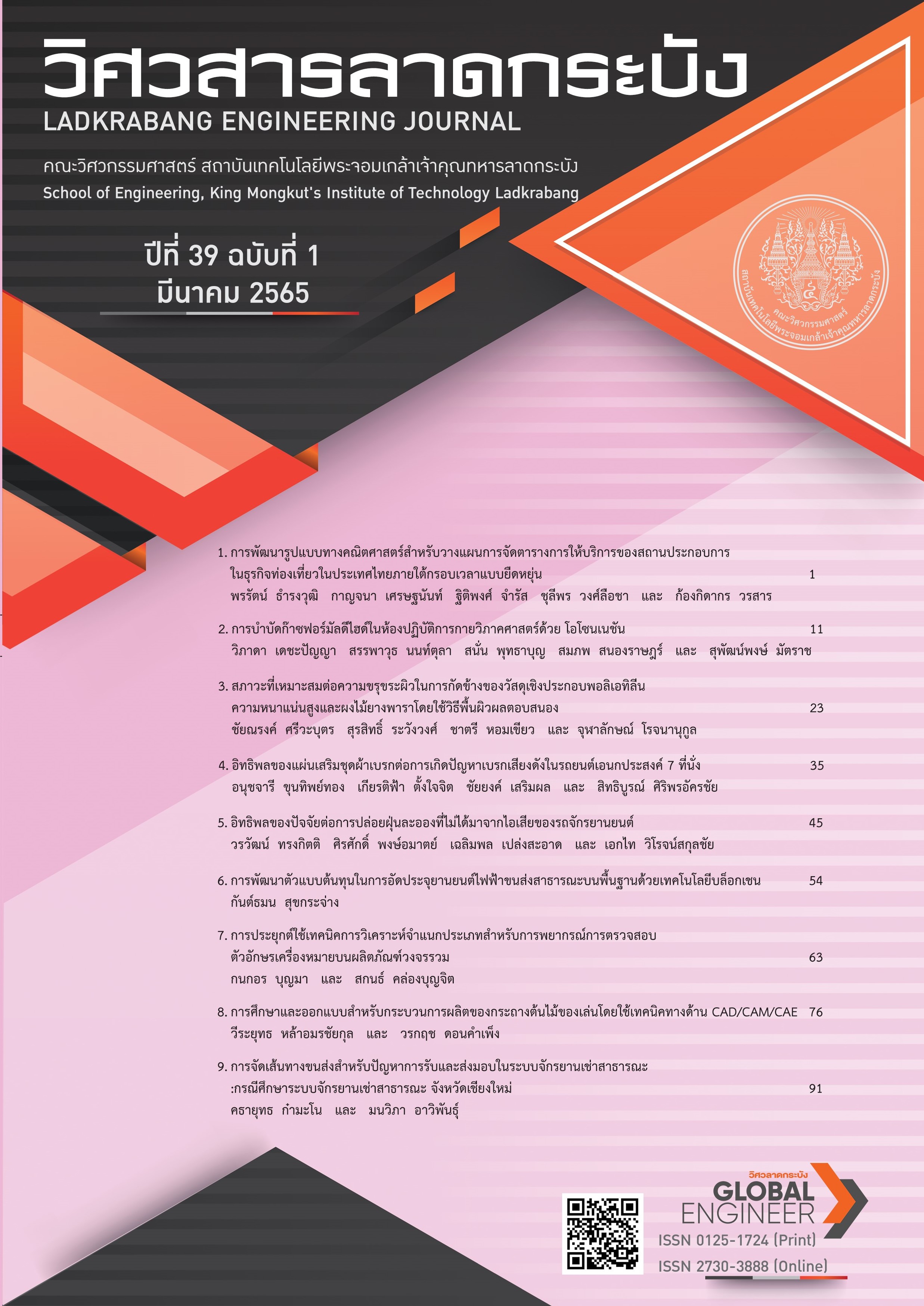การศึกษาและออกแบบสำหรับกระบวนการผลิตของกระถางต้นไม้ของเล่นโดยใช้เทคนิคทางด้าน CAD/CAM/CAE
คำสำคัญ:
แม่พิมพ์ฉีดพลาสติก, แบบจำลองเชิงตัวเลข, คอมพิวเตอร์ช่วยในการผลิตบทคัดย่อ
กระถางต้นไม้ของเล่นถูกนำมาใช้สำหรับจัดห้องเรียนและสวนสนุก ทุกวันนี้ชิ้นส่วนกระถางต้นไม้ของเล่นส่วนใหญ่ทำจากวัสดุพลาสติกโดยผ่านกระบวนการฉีดขึ้นรูป ชิ้นส่วนแม่พิมพ์ฉีดพลาสติกส่วนใหญ่ผลิตโดยกระบวนการของ CAM โปรแกรม InventorCAM คือคอมพิวเตอร์ช่วยในการผลิต (Computer Aided Manufacturing; CAM)) ที่พัฒนาและใช้งานในกระบวนการผลิตในอุตสาหกรรมยานยนต์ โปรแกรม InventorCAM ได้รับการเชื่อมโยงเพื่อทำงานร่วมกลับโปรแกรม Inventor โดยโปรแกรม InventorCAM จะมีใช้ในสำหรับการผลิตเท่านั้น ในงานนี้ผู้วิจัยได้ออกแบบโมเดลพลาสติกของกระถางต้นไม้ของเล่นและฐานแม่พิมพ์ ซึ่งประกอบด้วย sprue runner sub runner และ gate หลังจากนั้นจะใช้ชิ้นงานพลาสติกจำลองเพื่อจำลองการฉีดและการวางตำแหน่งการฉีดขึ้นรูป นอกจากนี้ยังออกแบบชิ้นส่วนมาตรฐานแม่พิมพ์ฉีดพลาสติก ด้วยโมดูลการออกแบบแม่พิมพ์ในโปรแกรม Inventor เวอร์ชัน 2014 ดังนั้นการศึกษานี้จึงสามารถศึกษาแม่พิมพ์ฉีดพลาสติกร่วมกับการใช้โปรแกรม InventorCAM อย่างเหมาะสม อย่างไรก็ตามผลลัพธ์ที่ได้จากการจำลองและการปรับปรุงประสิทธิภาพการฉีดพลาสติกที่สูงขึ้นจะเหมาะสมที่สุดสำหรับการพัฒนาการผลิตกระถางต้นไม้ของเล่นที่ดีขึ้นสำหรับธุรกิจ SME
References
S. Nazma, Md. Raihan Quader, Md. Jakaria and Md. H. Rahmn, “SolidCAM iMachining (2D): A Simulation Study of a Spur Gear Machining and G-code Generation for CNC Machine,” International Journal of Mechanical Engineering and Automation, vol. 3, no. 1, p. 1–9, 2016.
M. P. Groover and E. W. Zimmers, “Conventional Numerical Control,” in: CAD/CAM: Computer-Aided Design and Manufacturing, New Jersey, USA: Prentice-Hall, Inc, 1984, pp. 113
F. David and H. Ron, “CNC Machining Plastic Injection Mold Plates in the Classroom,” in 37th ASEE/IEEE Frontiers in Education Conference, Milwaukee, WI, USA, Oct. 10–13, 2007, pp. 12–17, doi: 10.1109/FIE.2007.4417886.
P. Izol, M. Tomas and J. Beno, “Milling strategies evaluation when simulating the forming dies functional surfaces production,” De Gruyter Open Eng, vol. 6, pp. 98–105, 2016, doi: 10.1515/eng-2016-0013.
J. Varga and E. Spisak, “Influence of the milling strategies on roundness of machined surfaces,” Acta Mechanica Slovaca, vol. 24, no. 3, pp. 20–27, 2020, doi: 10.21496/ams.2020.001.
M. Ficko, J. balic, I. Pahole, J. Senveter, S. Brezovnik and S. Klancnik, “Expectations of automatic programming of CNC machine tool,” Advances in Production Engineering and Management, vol. 5, no. 3, pp. 193–199, 2000.
Z. Rutkauskas and A. Bargelis, “Knowledge – based method for gate and cold runner definition in injection mold design,” Mechanika open access, vol. 4, no. 66, p. 49–54, 2007.
L. Werayoot, “The design of Plastic Injection Mold using Finite Element Analysis,” Narasuan University Engineering Journal, vol. 11, no. 1, pp. 101–109, 2016.
O. Thanit and T. Prawit, “Analysis of the Flow front on the Cup of Injection Mold.” Rajamangala University of Technology Suvarnabhumi, Phranakhon Si Ayutthaya, Thailand, Research. Rep. 1–97, 2014.
L. Dalio, R. Francesco, B. Federico, C. Matteo, Q. Danilo, Z. Yang and T. Guido, “Experimental Validation of Injection Molding Simulations of 3D Micro parts and Micro Structured Components Using Virtual Design of Experiments and Multi-Scale Modeling,” Micromachines, vol. 11, no. 6, pp. 614, 2020, doi: 10.3390/mi11060614.
H. H. Chang, C. A. Hieber and K. K. Wang, “A unified Simulation of the Filling and Post-Filling Stages in Injection Molding. Part I Formulation,” Polymer Engineering & Science, vol. 31, no. 2, pp. 116–124, 1991, doi: 10.1002/pen.760310210.
Downloads
เผยแพร่แล้ว
How to Cite
ฉบับ
บท
License
Copyright (c) 2022 คณะวิศวกรรมศาสตร์ สถาบันเทคโนโลยีพระจอมเกล้าเจ้าคุณทหาร

This work is licensed under a Creative Commons Attribution-NonCommercial-NoDerivatives 4.0 International License.
บทความที่ได้รับการตีพิมพ์เป็นลิขสิทธิ์ของคณะวิศวกรรมศาสตร์ สถาบันเทคโนโลยีพระจอมเกล้าเจ้าคุณทหารลาดกระบัง
ข้อความที่ปรากฏในบทความแต่ละเรื่องในวารสารวิชาการเล่มนี้เป็นความคิดเห็นส่วนตัวของผู้เขียนแต่ละท่านไม่เกี่ยวข้องกับสถาบันเทคโนโลยีพระจอมเกล้าเจ้าคุณทหารลาดกระบัง และคณาจารย์ท่านอื่นๆในสถาบันฯ แต่อย่างใด ความรับผิดชอบองค์ประกอบทั้งหมดของบทความแต่ละเรื่องเป็นของผู้เขียนแต่ละท่าน หากมีความผิดพลาดใดๆ ผู้เขียนแต่ละท่านจะรับผิดชอบบทความของตนเองแต่ผู้เดียว






